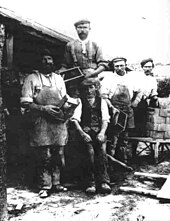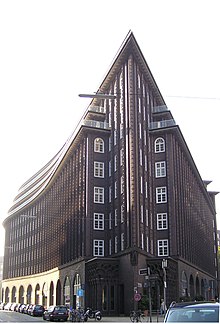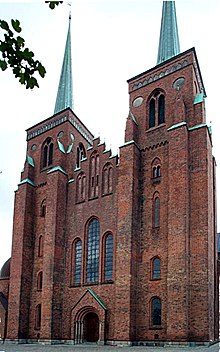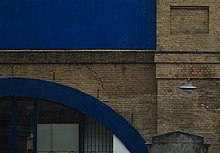The earliest bricks were
dried brick, meaning they were formed from clay-bearing earth or mud and dried (usually in the sun) until they were strong enough for use. The oldest discovered bricks, originally made from shaped mud and dating before 7500 BC, were found at
Tell Aswad, in the upper
Tigris region and in southeast
Anatolia close to
Diyarbakir.
[2] Other more recent findings, dated between 7,000 and 6,395 BC, come from
Jericho,
Catal Hüyük, and the ancient
Indus Valley cities of
Buhen,
Mohenjo-daro,
Harappa,
[3] and
Mehrgarh.
[4]
The
Romans made use of fired bricks, and the
Roman legions, which operated mobile
kilns,
[citation needed] introduced bricks to many parts of the empire.
Roman bricks are often stamped with the mark of the legion that supervised their production. The use of bricks in southern and western
Germany, for example, can be traced back to traditions already described by the Roman architect
Vitruvius.
The oldest domestic bricks were found in Greece. In the 12th century, bricks from Northern-Western
Italy were re-introduced to Northern Germany
[citation needed], where an independent tradition evolved. It culminated in the so-called
brick Gothic, a reduced style of
Gothic architecture that flourished in
Northern Europe, especially in the regions around the
Baltic Sea, which are without natural rock resources. Brick Gothic buildings, which are built almost exclusively of bricks, are to be found in
Denmark,
Germany,
Poland, and
Russia.
During the
Renaissance and the
Baroque, visible brick walls were unpopular
[dubious – discuss] and the
brickwork was often covered with
plaster. It was only during the mid-18th century that visible brick walls regained some degree of popularity, as illustrated by the Dutch Quarter of
Potsdam, for example.
The transport in bulk of building materials such as bricks over long distances was rare before the age of canals, railways, roads and heavy goods vehicles. Before this time bricks were generally made close to their point of intended use. It has been estimated
[by whom?]that in England in the 18th century carrying bricks by horse and cart for ten miles (approx. 16 km) over the poor roads then existing could more than double their price.
[citation needed]
Bricks were often used for reasons of speed and economy, even in areas where stone was available. The buildings of the Industrial Revolution in Britain were largely constructed of brick and timber due to the demand created. During the building boom of the 19th century in the eastern seaboard cities of
Boston and
New York City, for example, locally made bricks were often used in construction in preference to the
brownstones of
New Jersey and
Connecticut for these reasons.
The trend of building high office buildings that emerged towards the beginning of the 19th century displaced brick in favor of cast and wrought iron and later steel and
concrete. Some early '
skyscrapers' were made in masonry, and demonstrated the limitations of the material – for example, the
Monadnock Building in Chicago (opened in 1896) is masonry and just 17 stories high; the ground walls are almost 6 feet (1.8 m) thick to give the needed support; clearly building any higher would lead to excessive loss of internal floor space on the lower floors. Brick was revived for high structures in the 1950s following work by the
Swiss Federal Institute of Technology[disambiguation needed] and the
Building Research Establishment in
Watford, UK. This method produced 18-story structures with load-bearing walls no thicker than a single brick (150–225 mm). This potential has not been fully developed because of the ease and speed in building with other materials; in the late 20th century brick was confined to low- or medium-rise structures or as a thin decorative cladding over concrete-and-steel buildings or for internal non-load-bearing walls.
In Victorian London, bright red brick was chosen to make buildings more visible in the heavy fog that caused transport problems.
[5]
In
pre-modern China, brick-making was the job of a lowly and unskilled artisan, but a kiln master was respected as a step above the former.
[6] Early traces of bricks were found in a ruin site in
Xi'an in 2009 dated back about 3800 years ago. Before this discovery, it is widely believed that bricks appeared about 3000 years ago in the
Western Zhou dynasty since the earliest bricks were found in
Western Zhou ruins.
[7][8][9] These bricks are the earliest bricks discovered that were made by a fired process.
[10] Early descriptions of the production process and
glazing techniques used for bricks can be found in the
Song Dynasty carpenter's manual
Yingzao Fashi, published in 1103 by the government official Li Jie, who was put in charge of overseeing public works for the central government's construction agency. The historian
Timothy Brook writes of the production process in
Ming Dynasty China (aided with visual illustrations from the
Tiangong Kaiwu encyclopedic text published in 1637):
…the kilnmaster had to make sure that the temperature inside the kiln stayed at a level that caused the clay to shimmer with the colour of molten gold or silver. He also had to know when to quench the kiln with water so as to produce the surface glaze. To anonymous laborers fell the less skilled stages of brick production: mixing clay and water, driving oxen over the mixture to trample it into a thick paste, scooping the paste into standardized wooden frames (to produce a brick roughly 42
cm long, 20 cm wide, and 10 cm thick), smoothing the surfaces with a wire-strung bow, removing them from the frames, printing the fronts and backs with stamps that indicated where the bricks came from and who made them, loading the kilns with fuel (likelier wood than coal), stacking the bricks in the kiln, removing them to cool while the kilns were still hot, and bundling them into pallets for transportation. It was hot, filthy work.
[11]
The idea of signing the worker's name and birth date on the brick and the place where it was made was not new to the Ming era and had little or nothing to do with vanity.
[12] As far back as the
Qin Dynasty (221 BC–206 BC), the government required
blacksmiths and weapon-makers to engrave their names onto weapons in order to trace the weapons back to them, lest their weapons should prove to be of a lower quality than the standard required by the government.
[13]

Brick making at the beginning of the 20th century.
Modern clay bricks are formed in one of three processes – soft mud, dry press, or extruded.
Normally, brick contains the following ingredients:
[14]
- Silica (sand) – 50% to 60% by weight
- Alumina (clay) – 20% to 30% by weight
- Lime – 2 to 5% by weight
- Iron oxide – ≤ 7% by weight
- Magnesia – less than 1% by weight
The soft mud method is the most common, as it is the most economical. It starts with the raw clay, preferably in a mix with 25–30% sand to reduce shrinkage. The clay is first ground and mixed with water to the desired consistency. The clay is then pressed into steel moulds with a
hydraulic press. The shaped clay is then fired ("burned") at 900–1000 °C to achieve strength.
In modern
brickworks, this is usually done in a continuously fired tunnel
kiln, in which the bricks are fired as they move slowly through the kiln on
conveyors, rails, or kiln cars, which achieves a more consistent brick product. The bricks often have
lime, ash, and organic matter added, which accelerates the burning process.
In
India, brick making is typically a manual process. The most common type of brick kiln in use there is the
Bull's Trench Kiln (BTK), based on a design developed by British engineer W. Bull in the late 19th century.
An oval or circular trench is dug, 6–9 metres wide, 2-2.5 metres deep, and 100–150 metres in circumference. A tall exhaust chimney is constructed in the centre. Half or more of the trench is filled with "green" (unfired) bricks which are stacked in an open lattice pattern to allow airflow. The lattice is capped with a roofing layer of finished brick.
In operation, new green bricks, along with roofing bricks, are stacked at one end of the brick pile; cooled finished bricks are removed from the other end for transport to their destinations. In the middle, the brick workers create a firing zone by dropping fuel (coal,
wood, oil, debris, and so on) through access holes in the roof above the trench.
The advantage of the BTK design is a much greater energy efficiency compared with
clamp or
scove kilns. Sheet metal or boards are used to route the airflow through the brick lattice so that fresh air flows first through the recently burned bricks, heating the air, then through the active burning zone. The air continues through the green brick zone (pre-heating and drying the bricks), and finally out the chimney, where the rising gases create suction which pulls air through the system. The reuse of heated air yields savings in fuel cost.
As with the rail process above, the BTK process is continuous. A half dozen laborers working around the clock can fire approximately 15,000–25,000 bricks a day. Unlike the rail process, in the BTK process the bricks do not move. Instead, the locations at which the bricks are loaded, fired, and unloaded gradually rotate through the trench.
[15]
The dry press method is similar to the soft mud brick method, but starts with a much thicker clay mix, so it forms more accurate, sharper-edged bricks. The greater force in pressing and the longer burn make this method more expensive.
For extruded bricks the clay is mixed with 10–15%
water (stiff extrusion) or 20–25% water (soft extrusion). This mixture is forced through a
die to create a long cable of material of the desired width and depth. This mass is then cut into bricks of the desired length by a wall of wires. Most structural bricks are made by this method as it produces hard, dense bricks, and suitable dies can produce holes or other perforations as well. The introduction of such holes reduces the volume of clay needed, and hence the cost. Hollow bricks are lighter and easier to handle, and have different thermal properties than solid bricks. The cut bricks are hardened by drying for 20 to 40 hours at 50 to 150 °C before being fired. The heat for drying is often waste heat from the
kiln.
European-style extruded bricks or blocks are used in single-wall construction with finishes applied on the inside and outside. Their many voids comprise a greater proportion of the volume than the solid, thin walls of fired clay. Such bricks are made in 15-, 25-, 30-, 42- and 50-cm widths. Some models have very high thermal insulation properties, making them suitable for
zero-energy buildings.
The raw materials for calcium-silicate bricks include
lime mixed with
quartz, crushed
flint or crushed siliceous rock together with mineral
colourants. The materials are mixed and left until the lime is completely hydrated; the mixture is then pressed into moulds and cured in an
autoclave for two or three hours to speed the chemical hardening. The finished bricks are very accurate and uniform, although the sharp
arrises need careful handling to avoid damage to brick (and bricklayer). The bricks can be made in a variety of colours; white is common but pastel shades can be achieved. This type of brick is common in Sweden, especially in houses built or renovated in the 1970s, where it is known as "Mexitegel" (en: Mexi[can] Bricks). In India these are known as
Fly ash bricks, manufactured using the FaL-G (fly ash, lime and gypsum) process. Calcium-silicate bricks are also manufactured in Canada and the United States, and meet the criteria set forth in ASTM C73 – 10 Standard Specification for Calcium Silicate Brick (Sand-Lime Brick). It has lower embodied energy than cement based man-made stone and clay brick.
[citation needed]

A concrete brick-making assembly line in
Guilinyang Town, Hainan, China. This operation produces a pallet containing 42 bricks, approximately every 30 seconds.
Bricks of concrete with sand aggregate can be made using a simple machine and a basic assembly line. A conveyor belt adds the mixture to a machine, which pours a measured amount of concrete into a form. The form is vibrated to remove bubbles, after which it is raised to reveal the wet bricks, spaced out on a plywood sheet. A small elevator then stacks these palettes, after which a forklift operator moves them to the
brickyard for drying.
The fired colour of clay bricks is influenced by the chemical and mineral content of the raw materials, the firing temperature, and the atmosphere in the kiln. For example, pink coloured bricks are the result of a high iron content, white or yellow bricks have a higher lime content. Most bricks burn to various red hues; as the temperature is increased the colour moves through dark red, purple and then to brown or grey at around
1,300 °C (2,372 °F). Calcium silicate bricks have a wider range of shades and colours, depending on the colourants used. The names of bricks may reflect their origin and colour, such as
London stock brick and Cambridgeshire White.
"Bricks" formed from
concrete are usually termed blocks, and are typically pale grey in colour. They are made from a dry, small aggregate concrete which is formed in steel moulds by vibration and compaction in either an "egglayer" or static machine. The finished blocks are cured rather than fired using low-pressure steam. Concrete blocks are manufactured in a much wider range of shapes and sizes than clay bricks and are also available with a wider range of face treatments – a number of which simulate the appearance of clay bricks.
An impervious and ornamental surface may be laid on brick either by
salt glazing, in which salt is added during the burning process, or by the use of a "slip," which is a glaze material into which the bricks are dipped. Subsequent reheating in the kiln fuses the slip into a glazed surface integral with the brick base.
Natural stone bricks are of limited modern utility due to their enormous comparative mass, the consequent foundation needs, and the time-consuming and skilled labour needed in their construction and laying. They are very durable and considered more handsome than clay bricks by some. Only a few stones are suitable for bricks. Common materials are
granite,
limestone and
sandstone. Other stones may be used (for example,
marble,
slate,
quartzite, and so on) but these tend to be limited to a particular locality.
Optimal dimensions, characteristics, and strength[edit source | editbeta]
For efficient handling and laying, bricks must be small enough and light enough to be picked up by the bricklayer using one hand (leaving the other hand free for the trowel). Bricks are usually laid flat and as a result the effective limit on the width of a brick is set by the distance which can conveniently be spanned between the thumb and fingers of one hand, normally about four inches (about 100 mm). In most cases, the length of a brick is about twice its width, about eight inches (about 200 mm) or slightly more. This allows bricks to be laid
bonded in a structure which increases stability and strength (for an example, see the illustration of bricks laid in
English bond, at the head of this article). The wall is built using alternating courses of
stretchers, bricks laid longways, and
headers, bricks laid crossways. The headers tie the wall together over its width. In fact, this wall is built in a variation of
English bond called
English cross bond where the successive layers of stretchers are displaced horizontally from each other by half a brick length. In true
English bond, the perpendicular lines of the stretcher courses are in line with each other.
A bigger brick makes for a thicker (and thus more insulating) wall. Historically, this meant that bigger bricks were necessary in colder climates (see for instance the slightly larger size of the Russian brick in table below), while a smaller brick was adequate, and more economical, in warmer regions. A notable illustration of this correlation is the
Green Gate in Gdansk; built in 1571 of imported Dutch brick, too small for the colder climate of Gdansk, it was notorious for being a chilly and drafty residence. Nowadays this is no longer an issue, as modern walls typically incorporate specialized insulation materials.
The correct brick for a job can be selected from a choice of colour, surface texture, density, weight, absorption and pore structure, thermal characteristics, thermal and moisture movement, and fire resistance.
Face brick ("house brick") sizes, (alphabetical order)
| Standard | Imperial | Metric |
|---|
 Australia Australia | 9 × 4⅓ × 3 in | 230 × 110 × 76 mm |
 Denmark Denmark | 9 × 4¼ × 2¼ in | 228 × 108 × 54 mm |
 Germany Germany | 9 × 4¼ × 2¾ in | 240 × 115 × 71 mm |
 India India | 9 × 4¼ × 2¾ in | 228 × 107 × 69 mm |
 Romania Romania | 9 × 4¼ × 2½ in | 240 × 115 × 63 mm |
 Russia Russia | 10 × 4¾ × 2½ in | 250 × 120 × 65 mm |
 South Africa South Africa | 8¾ × 4 × 3 in | 222 × 106 × 73 mm |
 Sweden Sweden | 10 × 4¾ × 2½ in | 250 × 120 × 62 mm |
 United Kingdom United Kingdom | 8½ × 4 × 2½ in | 215 × 102.5 × 65 mm |
 United States United States | 7⅝ × 3⅝ × 2¼ in | 194 × 92 × 57 mm |
In
England, the length and width of the common brick has remained fairly constant over the centuries (but see
brick tax), but the depth has varied from about two inches (about 51 mm) or smaller in earlier times to about two and a half inches (about 64 mm) more recently. In the
United Kingdom, the usual size of a modern brick is 215 × 102.5 × 65 mm (about
8 5⁄8 ×
4 1⁄8 ×
2 5⁄8 inches), which, with a nominal 10 mm (
3⁄8 inch) mortar joint, forms a
unit size of 225 × 112.5 × 75 mm (9 ×
4 1⁄2 × 3 inches), for a ratio of 6:3:2.
In the
United States, modern standard bricks are (controlled by American Society for Testing and Materials
ASTM [16]) about 8 ×
3 5⁄8 ×
2 1⁄4 inches (203 × 92 × 57 mm). The more commonly used is the modular brick
7 5⁄8 ×
3 5⁄8 ×
2 1⁄4 inches (194 × 92 × 57 mm). This modular brick of
7 5⁄8 plus a
3⁄8 mortar joint eased the calculations of the number of bricks in a given run.
[17]
Some brickmakers create innovative sizes and shapes for bricks used for plastering (and therefore not visible) where their inherent mechanical properties are more important than their visual ones.
[18] These bricks are usually slightly larger, but not as large as blocks and offer the following advantages:
- a slightly larger brick requires less mortar and handling (fewer bricks), which reduces cost
- their ribbed exterior aids plastering
- more complex interior cavities allow improved insulation, while maintaining strength.
Blocks have a much greater range of sizes. Standard coordinating sizes in length and height (in mm) include 400×200, 450×150, 450×200, 450×225, 450×300, 600×150, 600×200, and 600×225; depths (work size, mm) include 60, 75, 90, 100, 115, 140, 150, 190, 200, 225, and 250. They are usable across this range as they are lighter than clay bricks. The density of solid clay bricks is around 2,000 kg/m³: this is reduced by frogging, hollow bricks, and so on, but aerated autoclaved concrete, even as a solid brick, can have densities in the range of 450–850 kg/m³.
Bricks may also be classified as solid (less than 25% perforations by volume, although the brick may be "frogged," having indentations on one of the longer faces), perforated(containing a pattern of small holes through the brick, removing no more than 25% of the volume), cellular (containing a pattern of holes removing more than 20% of the volume, but closed on one face), or hollow (containing a pattern of large holes removing more than 25% of the brick's volume). Blocks may be solid, cellular or hollow
The term "frog" for the indentation on one bed of the brick is a word that often excites curiosity as to its origin. The most likely explanation is that brickmakers also call the block that is placed in the mould to form the indentation a frog. Modern brickmakers usually use plastic frogs but in the past they were made of wood. When these are wet and have clay on them they resemble the amphibious kind of frog and this is where they got their name. Over time this term also came to refer to the indentation left by them. On the laying of frogged brick see
[1]
The compressive strength of bricks produced in the United States ranges from about 1000 lbf/in² to 15,000 lbf/in² (7 to 105
MPa or N/mm² ), varying according to the use to which the brick are to be put. In England clay bricks can have strengths of up to 100
MPa, although a common house brick is likely to show a range of 20–40
MPa.
Bricks are used for building,
block paving and
pavement. In the USA, brick pavement was found incapable of withstanding heavy traffic, but it is coming back into use as a method of
traffic calming or as a decorative surface in
pedestrian precincts. For example, in the early 1900s, most of the streets in the city of
Grand Rapids,
Michigan were paved with brick. Today, there are only about 20 blocks of brick paved streets remaining (totalling less than 0.5 percent of all the streets in the city limits).
[19]
Bricks in the
metallurgy and
glass industries are often used for lining
furnaces, in particular
refractory bricks such as
silica,
magnesia,
chamotte and neutral (
chromomagnesite)
refractory bricks. This type of brick must have good
thermal shock resistance,
refractorinessunder load, high melting point, and satisfactory
porosity. There is a large refractory
brick industry, especially in the
United Kingdom,
Japan, the
United States,
Belgium and the
Netherlands.
In Northwest Europe, bricks have been used in construction for centuries. Until recently, almost all houses were built almost entirely from bricks. Although many houses are now built using a mixture of
concrete blocks and other materials, many houses are skinned with a layer of bricks on the outside for aesthetic appeal.
Engineering bricks are used where strength, low water porosity or acid (flue gas) resistance are needed.
Colombian architect
Rogelio Salmona was noted for his extensive use of red brick in his buildings and for using natural shapes like spirals, radial geometry and curves in his designs.
[20] Most buildings in
Colombia are made of brick, given the abundance of clay in equatorial countries like this one.
Starting in the 20th century, the use of brickwork declined in many areas due to earthquakes. The
San Francisco earthquake of 1906revealed the weaknesses of brick buildings in earthquake-prone areas. Many buildings in San Francisco collapsed during the earthquake, due to the cement-based mortar used to hold the bricks together. During seismic events, the mortar cracks and crumbles, and the bricks are no longer held together.

























Follow Us
Were this world an endless plain, and by sailing eastward we could for ever reach new distances